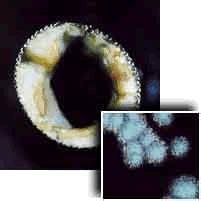
Water is used to cool and remove heat from the liquid plastic once it fills the mold. Cooling water flows through holes and channels drilled and cut in the mold tool. These ports in the mold tool are engineered to optimize the flow of water so that the plastic cools enough to allow the newly molded part to come out of the mold as a solid object.
The time it takes between new parts coming out of the mold is referred to as Cycle Time. The Cycle Time for each part depends on a number of design parameters including the flow rate and heat transfer capacity of the mold tool. The heat transfer capacity of the mold tool is reduced if scale, corrosion by-products or biofilm accumulate on the waterside of the mold.
This results in increased Cycle Time which in turn results in higher operating costs and lower output of the machine. Proper cleaning, layup and maintenance practices can completely prevent increased Cycle Time problems.
Closed loops rarely have scale problems, but mineral scale can form in systems with high hardness and alkalinity make-up sources. Mold surfaces are generally the hottest point in the system and high skin surface temperatures are prone to scale precipitation. Scale the thickness of a human hair can result in a 20% loss of heat exchange efficiency and that translates directly to increased Cycle Time.
Learn More About Our Closed Loop Services
ASHRAE defines a “closed loop” as a system that loses less than 10% of its volume annually. Most plastic injection mold loops lose significantly more than 10% of their volume when mold tools are changed. Figure out how much water your mold tools hold, then multiply that volume by the number of mold changes you make each year. Add in cleaning and flushing of the water attachment manifold (you do flush the water manifold before connecting the new, clean mold, right?) and any other cleaning and maintenance practices that include water replacement. Multiply that number by ten and compare it to your system volume.
Virtually all recirculating water systems contain some steel components. A good water treatment program can minimize the effects of corrosion, but not stop it completely. Corrosion causes iron and other metals to accumulate in the water and inadequate water treatment can allow those corrosion by-products to accumulate and lead to fouling on heat exchange surfaces.
Fouling insulates heat transfer and leads to increased Cycle Time. For plastic injection molders, the mold tool is the worst place for corrosion by-products to build up.

It is rarely practical or cost-effective to eliminate all bacteria from a recirculating water system. Semi-closed loops usually have open or loosely covered sumps that allow bacteria to enter the water. Bacteria can also enter the water when mold tools are changed.
Some bacteria in the water is not a problem and can easily be handled by a competent water treatment program. Bacteria that is allowed to grow unchecked eventually secrete slime to protect themselves. The slime layer allows bacteria to stick to surfaces. It also allows corrosion by-products, airborne contaminants and other living and dead bacteria to stick to surfaces. That slime layer is called biofilm.
An effective practice is to always maintain quality water treatment program that minimizes the need for aggressive cleaning products and procedures, but even the best water treatment program will require cleaning and layup after the mold tool is removed from the system.
After the mold tool is removed from the machine, connect the mold tool to a pump that circulates a cleaning solution through the mold. If scale problems exist, use a cleaning solution of OxSol diluted 5:1 with water. Biofilm problems should be addressed with a cleaning mixture containing Filmex 100 and a biocide such as Algex 200. Corrosion by-products can be removed with a combination of these products.
The last step in the cleaning program should be a solution of CharPrep diluted 10:1 with water. Consult with your Chardon water treatment professional for a prescription to address your unique issues. Replace the cleaning solution periodically and as soon as the solution is darker than strong tea color.
The next step is just as important as circulating the cleaning solution. With the return hose still attached, connect an air line to the inlet side of the mold tool and purge the tool with compressed air. Once all of the water has been blown out of the tool, remove the return hose and blow more compressed air through the tool until the leaving air is no longer a spray or mist of water.
The cleaning solution will leave a passivation layer of phosphate on the tool that will protect it during the layup period, but you can undo all that hard work by filling the mold tool when it goes back online with system water that has been sitting idle in the water connection manifold. Always purge the connections until clean water flows before connecting the mold tool. Does clean water never flow? Check your water treatment program!